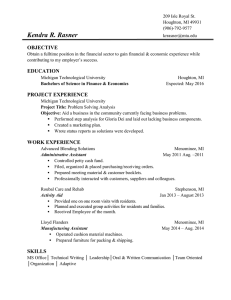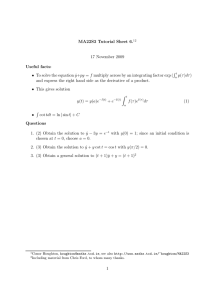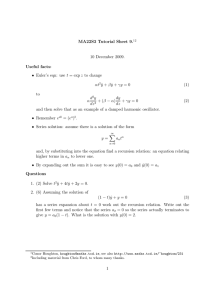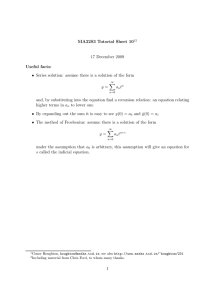SOURCES FOR RESEARCHING PROPERTY HISTORIES
advertisement
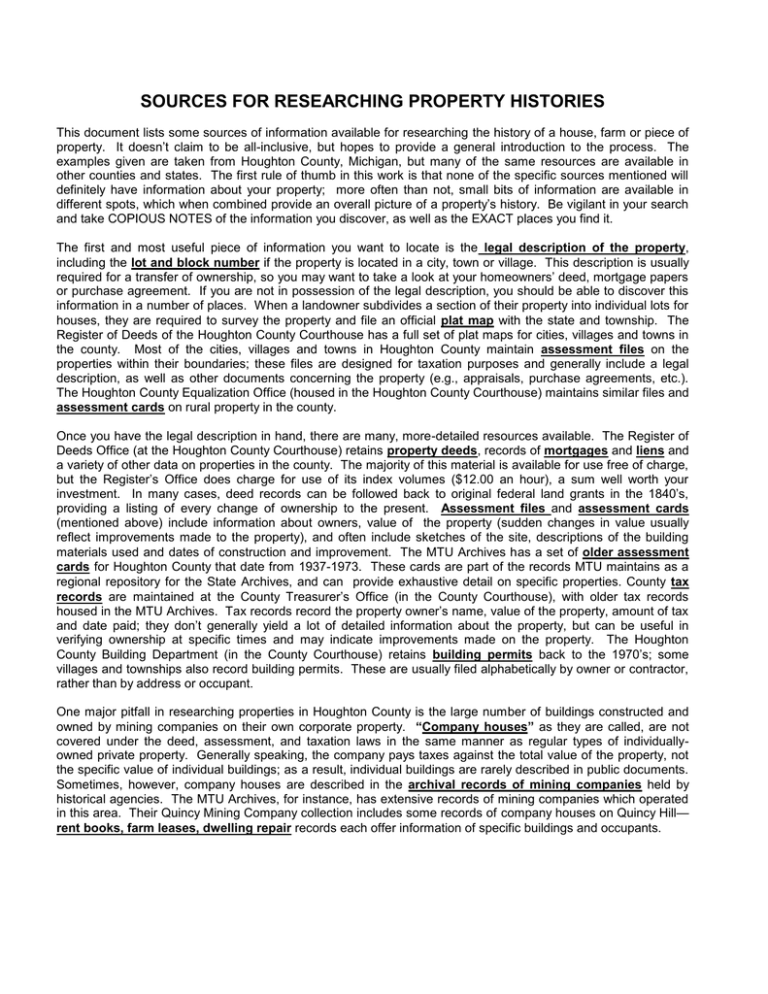
SOURCES FOR RESEARCHING PROPERTY HISTORIES This document lists some sources of information available for researching the history of a house, farm or piece of property. It doesn’t claim to be all-inclusive, but hopes to provide a general introduction to the process. The examples given are taken from Houghton County, Michigan, but many of the same resources are available in other counties and states. The first rule of thumb in this work is that none of the specific sources mentioned will definitely have information about your property; more often than not, small bits of information are available in different spots, which when combined provide an overall picture of a property’s history. Be vigilant in your search and take COPIOUS NOTES of the information you discover, as well as the EXACT places you find it. The first and most useful piece of information you want to locate is the legal description of the property, including the lot and block number if the property is located in a city, town or village. This description is usually required for a transfer of ownership, so you may want to take a look at your homeowners’ deed, mortgage papers or purchase agreement. If you are not in possession of the legal description, you should be able to discover this information in a number of places. When a landowner subdivides a section of their property into individual lots for houses, they are required to survey the property and file an official plat map with the state and township. The Register of Deeds of the Houghton County Courthouse has a full set of plat maps for cities, villages and towns in the county. Most of the cities, villages and towns in Houghton County maintain assessment files on the properties within their boundaries; these files are designed for taxation purposes and generally include a legal description, as well as other documents concerning the property (e.g., appraisals, purchase agreements, etc.). The Houghton County Equalization Office (housed in the Houghton County Courthouse) maintains similar files and assessment cards on rural property in the county. Once you have the legal description in hand, there are many, more-detailed resources available. The Register of Deeds Office (at the Houghton County Courthouse) retains property deeds, records of mortgages and liens and a variety of other data on properties in the county. The majority of this material is available for use free of charge, but the Register’s Office does charge for use of its index volumes ($12.00 an hour), a sum well worth your investment. In many cases, deed records can be followed back to original federal land grants in the 1840’s, providing a listing of every change of ownership to the present. Assessment files and assessment cards (mentioned above) include information about owners, value of the property (sudden changes in value usually reflect improvements made to the property), and often include sketches of the site, descriptions of the building materials used and dates of construction and improvement. The MTU Archives has a set of older assessment cards for Houghton County that date from 1937-1973. These cards are part of the records MTU maintains as a regional repository for the State Archives, and can provide exhaustive detail on specific properties. County tax records are maintained at the County Treasurer’s Office (in the County Courthouse), with older tax records housed in the MTU Archives. Tax records record the property owner’s name, value of the property, amount of tax and date paid; they don’t generally yield a lot of detailed information about the property, but can be useful in verifying ownership at specific times and may indicate improvements made on the property. The Houghton County Building Department (in the County Courthouse) retains building permits back to the 1970’s; some villages and townships also record building permits. These are usually filed alphabetically by owner or contractor, rather than by address or occupant. One major pitfall in researching properties in Houghton County is the large number of buildings constructed and owned by mining companies on their own corporate property. “Company houses” as they are called, are not covered under the deed, assessment, and taxation laws in the same manner as regular types of individuallyowned private property. Generally speaking, the company pays taxes against the total value of the property, not the specific value of individual buildings; as a result, individual buildings are rarely described in public documents. Sometimes, however, company houses are described in the archival records of mining companies held by historical agencies. The MTU Archives, for instance, has extensive records of mining companies which operated in this area. Their Quincy Mining Company collection includes some records of company houses on Quincy Hill— rent books, farm leases, dwelling repair records each offer information of specific buildings and occupants. 2 Maps are very useful tools in understanding a property’s history. Current street maps, including the maps of Calumet and Laurium created as part of Lynn Bjorkman’s survey, are vital to locating properties, identifying their comparative size and value in relation to other properties, and are also useful in identifying buildings on older maps. US Geological Survey topographical maps (also called “USGS toppos”) provide smaller scale representations of larger areas. They usually show buildings, as well as topographical features like elevations, rivers, forestation and urbanized areas. The Government Documents department of the Library at MTU has a current set of USGS maps for most states and maps of the local region are also available for purchase from many local merchants. Sanborn-Perris fire insurance maps show detailed information of mining company locations and townsites. These maps were created for sale to local insurance agents and, in their original form, use different colors to indicate building materials used in specific buildings. Sanborn-Perris visited areas every 4-10 years and a full set of these maps provide regular snapshots of specific cities, villages and mining locations. The MTU Archives has a set of Sanborn-Perris maps for the local area, although most are black & white copies on microfilm. The archival records of mining companies often include a variety of maps of interest in researching property histories. Blueprint copies of large-format maps are familiar sight on office walls around the area and many are housed in local historical societies and archives. One should be willing to examine various published items like books, magazine articles and newspapers for information about your property and nearby cities and towns. Many published surveys have been carried out on places in the Copper Country, for instance, which contain details of specific buildings and homes. The attached list includes several items that are in the MTU Archives, but there are many others housed in local public libraries, historical society’s and personal collections. Ask around and it will probably turn out that someone in your neighborhood has information about your property; a personal interview might be arranged and the details added to an oral history collection at one of the many repositories in your area. Although many of these published or personal sources may not have specific information about your property; a personal interview might be arranged and the details added to an oral history collection at one of the many repositories in your area. Although many of these published or personal sources may not have specific information about your property, they may have information that may shed light on your property – when a townsite was platted, when utility lines were added, when a railroad spur changed direction, etc. The photograph collections of archives and historical societies are another source of interest; although one shouldn’t expect a picture of their own home, there are many images of cities, towns and industrial sites that provide interest views of their surroundings. Finally, you may be interested to learn more about the individuals that have lived in your house, or who have owned your property. Information from deeds, assessment records and tax records may provide you with a chronology of names, but there are several sources that tell more about the people than their property. Federal and State census records list individuals, their residences, professions, ages, places of birth and other details for certain years. Polk City and County Directories list residence and profession, and in later years organize information by street address (a “reverse telephone directory”). Other public documents, like voting records and tax records list some relevant personal information, but are usually more useful as tools to verify residence or ownership at a particular time. Many of these older records are available at the MTU Archives and local historical societies, but certain records must remain permanently on file at the County Courthouse. Of these, the “vital” records of birth, naturalization, marriage and death are kept at the County Courthouse. These are of great interest to genealogists, but often reveal much about those that have preceded you in a particular place. The archival records of mining companies also include personnel records – particularly employment cards, payroll records, and accounting ledgers – that include details of individuals employed by the company. The key to successful research is persistence, good record-keeping and attitude. Small bits of information gleaned here and there build into fuller histories of houses, farms and properties. Remember that the keepers of these resources are usually overwhelmed with requests for information, so it is best to write or call an agency before (or instead of) making a personal visit. Many smaller organizations are only open seasonally (although some employ staff or volunteers to respond to mail queries through the winter months), some institutions are only open during normal business hours, and many charge small fees for accessing their holdings, having searches carried out, and having copies made. You’ll soon find that a slower, gentler approach will produce far greater results than a rushed, demanding attitude. 3 COUNTY COURTHOUSE Register of Deeds Office (in Houghton, 482-1311) -Plat Maps -Deeds -Mortgages -Liens County Equalization Office (in Houghton, 482-0250) -Computer print-out, cross-referencing street address and legal -Current Assessment cards County Clerk’s Office (in Houghton, 482-1150) -Birth records -Naturalization records -Marriage records -Death certificates County Treasurer’s Office (in Houghton, 482-0560) -Current tax records Building Department (in Houghton, 482-2260) -Building Permits (back to the 1970’s, when one was actually used) MTU ARCHIVES Polk County and City Directories Telephone Directories Census Records (federal and state) Voting Registers (noncurrent) County Tax Assessment cards (noncurrent) County, Tax Registers (noncurrent) Street Maps Sanborn-Perris Maps Topographical Maps Mining Company Maps Records in Mining Company Archival Collections -dwelling rents -land and farm leases -property sales Photograph Collections Local Planning Studies and Surveys -National State Register Nominations -Calumet-Laurium Region Comprehensive Plan (1969/1970) HT167.5.M5.C3 pts. 1&2 -WUPPDR Historic Preservation Plan (1977) F572.W45.W45 -Inventory of Historic Engineering and Industrial Sites in the U.P. (1978) T22.M5.U6 -Calumet Downtown Historic District (1979-1981) F574.C35.C27 pts. 1&2 -Michigan Copper Mining District Historic Resources Management Plan (Debra Dobson-Brown Study 1990) F572.K43.M52 -Lynn Bjorkman Study 1995/96 Other Published Material -Houses and Homes: exploring their history AASLH (1987) E180.H68 -Published histories of town, village, city or county e.g., Arthur Thurner Calumet Copper and People (1974) F574.C2.T48 Clarence Monette Early Red Jacket and Calumet in Pictures (1988, 1991) F574.C34.M65 -Books on architecture -Kathryn Eckert The Sandstone Architecture of the Lake Superior Region (1986) NA 726.E34 -Studies on development of cities, even creation of campus towns -Newspapers (MTU Archives maintains a clipping file) OTHER SOURCES Architectural/Construction Companies Personal Interviews Village/Township Offices Local Historical Societies/Museums -Houghton County Historical Society, Lake Linden (296-0420) -Keweenaw County Historical Society, Eagle Harbor (289-4900) -Copper Range Historical Society, South Range (296-2561) -Coppertown Museum, Calumet (337-4579) -Ontonagon Historical Society, Ontonagon (884-6165)

